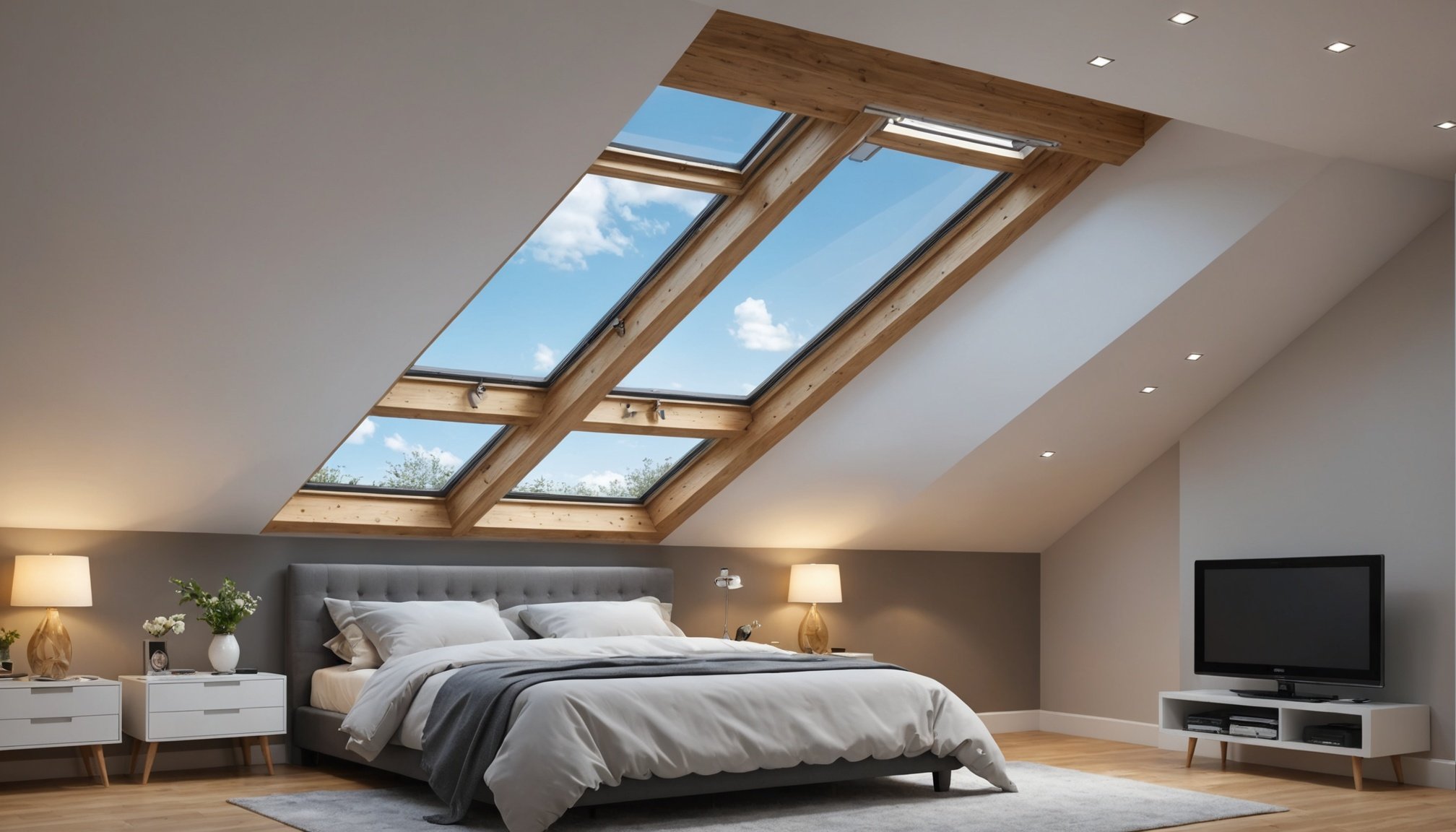Understanding Skylights and Their Benefits
Incorporating skylights in your attic can be a transformative home improvement choice, offering a multitude of benefits. Natural lighting benefits are among the most significant advantages, as they bring a vibrant atmosphere into your living space. This influx of daylight can enhance mood, reduce reliance on artificial lighting, and subsequently lower energy bills. By installing an attic skylight, you enjoy advantages of reduced energy consumption and increased light exposure, promoting better energy efficiency.
Various types of skylights are suitable for attics, each providing unique benefits. Fixed skylights offer permanent, unchanging light sources, while ventilating skylights permit circulation, reducing moisture build-up. Tubular skylights are compact and excellent for smaller spaces, reflecting natural light into previously inaccessible areas.
Long-term, these benefits can equate to significant cost savings. The reduction in artificial lighting and improved energy efficiency contribute to these savings. Moreover, the natural light provided by skylights can offer substantial psychological benefits, fostering a more cheerful and inviting living environment.
Choosing the right type of skylight can profoundly impact aesthetics and functionality, all while providing sustainable natural lighting benefits that contribute to cost efficiency and well-being.
Have you seen this : Revitalize your workspace: key design strategies to boost productivity in your uk home office
Planning Your Skylight Installation
Planning your skylight installation requires thoughtful consideration of your attic space. Begin by precisely assessing and measuring the area where you envisage the skylight. This step ensures that the skylight not only fits but also optimises light input. Design considerations play a pivotal role; it’s essential to maximise natural light while adeptly minimising any heat loss.
Moreover, contemplate the aesthetic impact on your home’s architecture. A well-placed skylight can enhance the visual appeal of your home, along with providing energy efficiency. Consider the style and size to maintain architectural harmony. Sometimes, using modular designs or translucent materials can help blend the skylight seamlessly with your existing structure.
Assess light angles and available types to achieve an optimal balance. Options like fixed or tubular skylights may cater differently based on your attic’s design and needs. Tailor the installation to suit your energy and lighting goals—this is crucial for a successful conversion that’s both practical and visually pleasing. Prioritising these design considerations can significantly elevate the experience and effectiveness of your new skylight installation strategy.
Necessary Permits and Regulations
When planning a skylight installation, obtaining the necessary skylight permits is a crucial step. Understanding UK building regulations is essential to ensure your project complies with legal requirements. Each region may have its own set of guidelines, particularly concerning fire and safety regulations specific to attic spaces. Contact local building authorities to get in-depth information.
Compliance tips can help streamline the process. Begin with a thorough review of local building regulations. Usually, you will need to submit a detailed plan that includes skylight design, materials, and placement. This step ensures structural safety and integrates seamlessly with your existing roof.
Fire safety regulations often require using materials that meet fire ratings. Ensure your chosen skylight complies with these standards, especially for attic spaces, as they can be more vulnerable in case of a fire. Engaging with a licensed contractor familiar with skylight permits can save time and prevent costly mistakes. They can provide insights and help you navigate the complexities of building regulations effectively.
Remember, adhering to regulations not only ensures safety but also adds value to your home by maintaining compliance.
Choosing the Right Materials
Selecting appropriate skylight materials is essential for durability and efficiency. Common options include glass and acrylic, each offering unique benefits. Glass skylights provide superior clarity and are scratch-resistant. They are also excellent at insulating, especially when double-glazed.
Alternatively, acrylic skylights are lightweight and resistant to impact, making them ideal for areas with strong weather conditions. Consider materials with UV protection to prevent harmful rays and reduce indoor fading.
Insulation properties are crucial in managing heat transfer and maintaining energy efficiency. Opt for durable skylight options featuring low-emissivity (Low-E) coatings, which reflect heat and improve performance. This increases indoor comfort and reduces energy demand for heating and cooling. When choosing materials, it’s wise to also think about the weather-resistance of your skylight.
Look for options that can withstand local climate conditions, ensuring longevity and reduced maintenance needs. By focusing on the right materials, you enhance both the energy efficiency and durability of your attic skylight, ensuring that it serves your home well in the long run.
Installation Techniques and Safety Precautions
When considering a DIY skylight installation in an attic, understanding precise skylight installation tips is key. Starting with a step-by-step approach helps in maintaining focus and accuracy throughout the process. Begin by accurately marking the location for the skylight, ensuring it aligns with your design considerations and optimises light intake.
Essential safety measures are crucial before and during installation. Use appropriate safety equipment like gloves, goggles, and a harness if working at height. Ensuring your tools are in good condition reduces risks of accidents.
Tools typically required include a saw, drill, measuring tape, and caulking gun. Proper sealing is vital to prevent leaks, particularly around joints. Adequate weatherproofing involves installing flashing to direct water away from the skylight.
Given the position of attic installations, regularly check that structural integrity remains uncompromised. Ensuring safety not only protects you but also secures your home’s structure.
While DIY approaches can save costs, consider hiring professionals for complex installations or if uncertain about any step in the process. Remember that correct installation enhances the attic skylight advantages by melding utility with safety.
Cost Estimation and Budgeting
Establishing a realistic budget is essential before beginning a skylight installation project. The skylight installation costs in the UK can range significantly, influenced by factors like materials, labour, and the complexity of the installation. On average, expect costs to vary between £900 to £2,500, with materials like glass typically being more expensive than acrylic due to enhanced durability and insulation properties.
Factors affecting costs include the type of skylight chosen, such as fixed, ventilating, or tubular, each with distinct price points. Labour fees depend on the ease of access to the attic and any additional structural modifications required. Custom designs or extensive attic conversions can also increase costs.
For effective budgeting, consider requesting quotes from multiple contractors to compare prices and services offered. Budgeting tips such as prioritising essential features and choosing materials with long-term savings in mind, like energy-efficient options, can help manage expenses. If financing is a consideration, explore options like home improvement loans or government incentives for energy-efficient upgrades, which may help alleviate some upfront costs.
Maintenance and Troubleshooting
Regular skylight maintenance is vital for ensuring long-term performance and maximising attic skylight advantages. Begin by inspecting the skylight periodically for any signs of damage or wear. Check seals and flashings to prevent leaks, which are common issues. Proper sealing and weatherproofing are crucial to avoid water ingress and heat loss.
For troubleshooting leaks, first, identify the source by examining the joints and flashing. A temporary fix could involve applying silicone caulking to the affected areas. For persistent leaks, it is advisable to consult a professional to prevent further damage.
Providing care involves cleaning the skylight regularly, using non-abrasive cleaners and tools to protect the surface. Ensure the skylight is free from debris, which can accumulate around openings and lead to blockages and potential damage.
Consider these tips to enhance the lifespan of your attic skylight:
- Schedule routine inspections to catch issues early.
- Check for condensation and improve ventilation if needed.
- Replace damaged parts promptly to maintain energy efficiency.
Adhering to these guidelines not only preserves the functionality of your skylight but also prolongs its effective service life, securing the benefits of natural lighting.
Resources and Further Reading
Exploring skylight resources can provide invaluable insights, ensuring your installation project is well-informed. Installation guides are available to aid both beginners and seasoned DIY enthusiasts, offering step-by-step instructions that highlight crucial techniques and potential pitfalls.
Consulting expert advice from experienced contractors can streamline the process. Engage with local UK specialists to gain tailored insights for your specific attic and structural conditions. This level of personalised expertise can be especially helpful for navigating unique architectural challenges or compliance issues.
For a more interactive learning experience, consider participating in community forums dedicated to skylight installations. These platforms serve as a repository of shared experiences and tips, fostering a collaborative environment where questions can be asked and answered.
Recommended topics often cover various aspects, such as:
- The latest innovations in skylight technology.
- Common troubleshooting techniques for persistent issues.
- Energy-saving strategies to maximise the benefits of your installation.
While individual projects vary, these resources serve as excellent starting points, empowering homeowners with knowledge and confidence to undertake successful skylight installations. Whether you’re seeking guidance or sharing your own experiences, engaging with a community enriched by diverse perspectives elevates your understanding.











